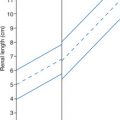Chapter 9. Breast
Patient Preparation
• No preparation is required.
Equipment and Technical Factors
• A high-frequency linear array is used for imaging the breast.
• To examine large superficial structure pathology, use a curved linear transducer to place the anatomy into the widest portion of the image.
Imaging Protocol
• Longitudinal and transverse axes images of the organ or area of interest
• When the breast is imaged, standardized labeling must be used (quadrant, radial/antiradial, clock face and distance from nipple).
• Correlate with mammography findings: for example, Bi-Rads classification and location.
• Patient positioning
Supine with ipsilateral arm raised or slightly oblique with ipsilateral arm raised (helpful for scanning left breast or large breast)
For a small-breasted patient, supine with arm down reduces compression of the breast tissue from tightened skin.
• Light transducer pressure is used to avoid compression of tissues and structures; compression is used in the evaluation of suspicious areas or masses.
Variants
• Tail of Spence, ectopic breast tissue, accessory (supernumerary) nipples.
Sonographic Measurements
• Length, depth, and width of the cyst, mass, or other diseased area.
| Breast | |||
|---|---|---|---|
| Sonographic Finding(s) | Clinical Presentation | Differential Diagnosis | Next Step |
Solid breast mass, homogenous with low level echoes, with/without acoustic attenuation Oval: “broader than tall”; compressible Well defined with smooth margins; gentle lobulations may be noted Calcifications may be noted | Palpable breast lump Nontender, firm, rubbery Pregnant patient may have noted rapid enlargement (from hormonal stimulation) Highly suspicious in postmenopausal women | Fibroadenoma | Color Doppler imaging and vocal fremitus may aid in benign determination to demonstrate peripheral flow around mass Demonstrate disruption or invasion of tissue planes Correlate with Bi-Rads classification |
Hyperechoic parenchyma with/without sound attenuation and shadowing; may present as hyperechoic mass Cysts or cyst clusters may be noted Ductal ectasia may be noted Stay updated, free articles. Join our Telegram channel
Full access? Get Clinical Tree


| |||

